IT Architecture Consulting
November 16, 2021

November 16, 2021

Fit for the future, flexibly adaptable, economical, and safe. That’s everything an IT architecture should ideally be. However, this is often not the case. That’s where our experienced experts come into play: We have mastered the high art of system integration – and we help companies when they are restructuring from historically grown island solutions to a consistent IT system environment.
Within the scope of IT architecture consulting, it is our task to question the existing IT infrastructure:
The result is a service-oriented IT system environment that is consistently aligned with the company’s goals and processes. A motivated and strong team with technological know-how and extensive experience in structured procedures: It is this combination that makes us a strong partner for small and large IT architecture analyses.
Before we talk about the actual consulting, we should first clarify what IT architecture is. Simply explained, these are different aspects of information technology in an organized structure, such as in an operation or company. That is, the necessary components – for example, IT systems, applications, integration interfaces, data structures, and infrastructure components – and their interplay.
Both technology standards and architectural principles are integral parts of the IT architecture. It can therefore include various modeling tools, frameworks, specifications, guidelines, and reference models.
Speaking of models: IT architectures have different tasks. On the one hand, they document the current state and thus ensure efficient inventory management of the IT components. On the other hand, IT architectures can serve as planning tools that map the ideal state.
Does the issue still seem a bit fuzzy? The following triggers and objectives illustrate what can be achieved with comprehensive IT architecture consulting.
Scenario 1:
Scenario 2:
Scenario 3:
Scenario 4:
Scenarios such as these illustrate the importance of the strategic development of IT architecture. Now it’s time to see how our consulting in this area works.
Every company “ticks” differently. Therefore, it is natural that every instance of IT architectural consulting has individual features. Nevertheless, there is a rough four-step process that is the same in each scenario – and we would like to explain this here.
When IT architectural consulting starts, it is a matter of getting an overview of all available information: Through IT tool lists, the strategy paper, and process overviews – or through interviews with the responsible IT managers. One of the goals is to find out what the intention or the basic concept of a (unknown) tool is.

Every company has stakeholders, that is, people who have a legitimate interest in internal projects and processes – for example, CIO, CTO, IT Managers, and process owners in the IT sector. In the second step of IT architecture consulting, we use individual interviews and focus groups to discuss relevant topics.
Possible interview questions might include:
Once all the information about the existing IT solution has been collected, step number three gets down to business. That is, the collected data is transferred to a model that is adapted to the company’s individual requirements. For this purpose, categorizations are made according to a whole series of criteria:
Following the development of the model, the results must be assessed both technically and strategically. Does what we thought about the IT architecture make sense – today, but especially in the future? That’s what we want to find out in this fourth and final step of the consultation.
Analysis of the following technical dimensions:
Analysis of the following strategic dimensions: At this point, the current IT architecture is compared to the strategic objectives. This can be explained more easily with a concrete example. Is the aim to offer customers all product-related services for all relevant channels from a single source? Then it is essential to merge the different commerce systems currently in place for the app, website, and third parties.
A summary of the four steps of IT architecture consulting: In the first two steps, there is a quantitative and qualitative survey of the status quo. These results are subsequently incorporated into a model system and analyzed in detail.
We look forward to hearing from you.
Don't miss a thing.
Subscribe to our latest blog articles.